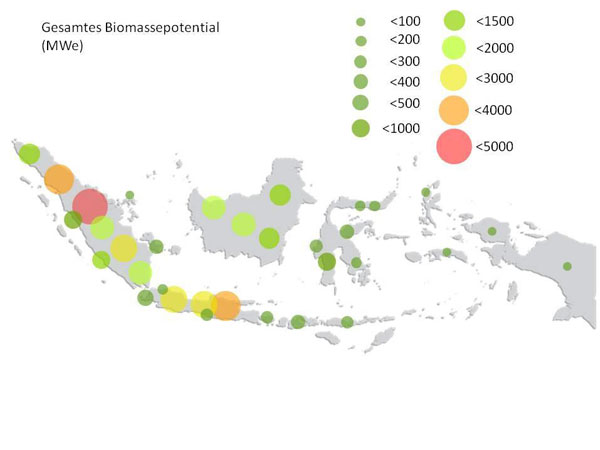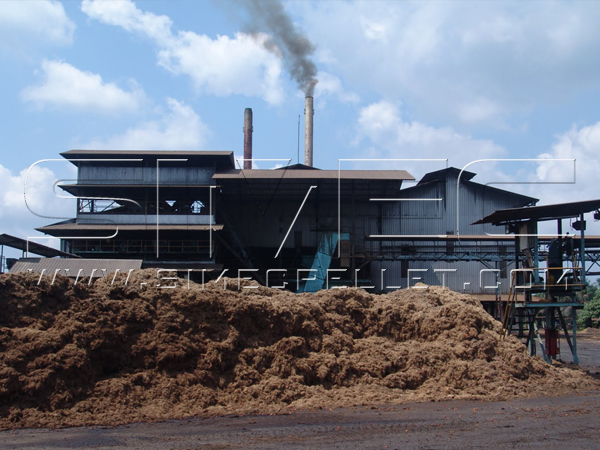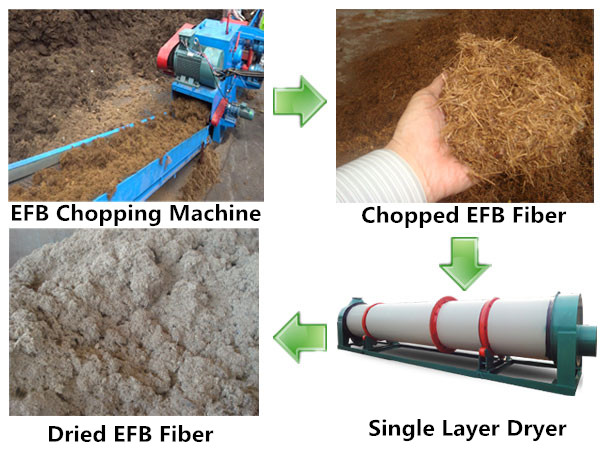The Affordable EFB Pretreatment Chopping Machine for Small Palm Oil Mills in Indonesia

Figure 1 :Potential plantation farm of biomass energy generation in Indonesia
With around 10 million hectares of palm oil plantations currently occupy about 5 percent of the total area of Indonesia. The first oil palm plantations were created in 1911 in Sumatra. Driven by the huge demand for palm oil plantations in Europe, this had spread to the late 1940s to the whole of Sumatra. The biggest growth spurt experienced the palm oil industry, however, since the 60s of the 20th century. From 157,000 tons in 1964, palm oil production has risen to more than 30 million tons in 2013. Currently, Indonesia, with more than 50 percent of global palm oil production off Malaysia's largest palm oil producer. In addition, the government plans to further expand production by 2020 to 40 million tons. With about 11 percent of the total value of all Indonesian exports is palm oil is one of the most important export product for the country.
Currently there are more than 600 palm oil mills and around 120 palm oil refineries. Further processing of crude palm oil, however, is little developed in Indonesia compared to the main competitors Malaysia. Due to the high investment costs for the construction of complex processing systems, the Indonesian palm oil business is dominated alongside local majors by Malaysian companies. The existing oil mills and refineries are overloaded, so that strong growth is expected in processing plants.
96% percent of all Indonesian oil palm plantations are located on the island of Sumatra and Kalimantan, the Indonesian part of Borneo. The long experience in the production of palm oil, oil palm plantations and associated infrastructure in Sumatra are more developed than elsewhere in Indonesia. The provinces of Riau, North Sumatra, South Sumatra and Jambi have the highest palm oil production. Together they are responsible for 60 percent of total palm oil production. In the main growing areas in Riau and North Sumatra cover oil palm plantations over 1 million hectares each.
Table 1: Oil palm cultivation and palm oil production of the ten most provinces in Indonesia 2013
| Province | Oil Palm Cultivation Area | Palm Oil Production |
| Riau | 2.139.800 ha | 6.499.800 t |
| North Sumatra | 1.222.900 ha | 4.147.700 t |
| Central Kalimantan | 1.126.500 ha | 3.055.100 t |
| South Sumatra | 898.200 ha | 2.552.400 t |
| West Kalimantan | 897.900 ha | 1.942.100 t |
| East Kalimantan | 789.400 ha | 1.393.700 t |
| Jambi | 696.800 ha | 1.760.400 t |
| South Kalimantan | 497.700 ha | 1.279.700 t |
| Aceh | 381.500 ha | 677.000 t |
| West Sumatra | 355.900 ha | 960.400 t |
Around 50 percent of rough palm oil is directly without being processed. The remaining 50 percent are processed to cooking oil, which is exported to the same parts and consumed locally.
The national government and local authorities play a central role in the development of the palm oil industry. The state promotes the growth of the sector with business licenses, land grants and the granting of long-term commercial leases (HGU), which allows the creation of large-scale oil palm plantations to 30 years in state land. The State regards the palm oil industry as a way to promote the economic development of the country and to raise the standard of living of the local population.
In the processing of oil palm fruits about 70-80 percent of the weight of fresh fruit bunches (FFB) remain as often unexploited biomass. With an estimated FFB weight of about 135 million Tonnen29 in the market year 2013/2014 in Indonesia, falling from 94.5 to 108 million tonnes of waste palm oil production, the optimum disposal represents a serious challenge.
By using as biomass in power a considerable amount of electricity could be generated. The dense and differentiated palm oil industry provides a good basis for the development of biomass energy.
Wide range of applications offer the remaining solids as fertilizer or mulch on the plantations and energy-related uses are common. Especially press cake and palm kernel shells serve many palm oil mills already present for generating the required electricity to operate the plant. This takes place on the path of the combustion and by the use of steam turbines. But the energetic use of solid residues is already sufficient for the current needs of a palm oil mill and also produces excess electricity. The empty fruit bunches are usually incinerated or land as mulch back to the plantations.
While solid residues are already salvaged and then profitably, mainly produces the treatment of liquid wastes still a challenge. The methane-containing waste water must be clarified prior to disposal. Their high nutrient content and richness of organic components makes this extremely polluting. They are usually collected in anaerobic reservoir. The changes taking place in the sewage ponds bio degradation processes release large amounts of greenhouse gases. When processing a ton of FFB arise in this way, 6.54 kg emission in the atmosphere. This corresponds to a CO2 equivalent of 137.4 kg per tonne of FFB. In addition, leaky pond pool cause repeatedly impurities from nearby waters and groundwater.
The national government and local authorities play a central role in the development of the palm oil industry. The state promotes the growth of the sector with business licenses, land grants and the granting of long-term commercial leases (HGU), which allows the creation of large-scale oil palm plantations to 30 years in state land. The State regards the palm oil industry as a way to promote the economic development of the country and to raise the standard of living of the local population.
In the processing of oil palm fruits about 70-80 percent of the weight of fresh fruit bunches (FFB) remain as often unexploited biomass. With an estimated FFB weight of about 135 million Tonnen29 in the market year 2013/2014 in Indonesia, falling from 94.5 to 108 million tonnes of waste palm oil production, the optimum disposal represents a serious challenge.
By using as biomass in power a considerable amount of electricity could be generated. The dense and differentiated palm oil industry provides a good basis for the development of biomass energy.
Wide range of applications offer the remaining solids as fertilizer or mulch on the plantations and energy-related uses are common. Especially press cake and palm kernel shells serve many palm oil mills already present for generating the required electricity to operate the plant. This takes place on the path of the combustion and by the use of steam turbines. But the energetic use of solid residues is already sufficient for the current needs of a palm oil mill and also produces excess electricity. The empty fruit bunches are usually incinerated or land as mulch back to the plantations.
While solid residues are already salvaged and then profitably, mainly produces the treatment of liquid wastes still a challenge. The methane-containing waste water must be clarified prior to disposal. Their high nutrient content and richness of organic components makes this extremely polluting. They are usually collected in anaerobic reservoir. The changes taking place in the sewage ponds bio degradation processes release large amounts of greenhouse gases. When processing a ton of FFB arise in this way, 6.54 kg emission in the atmosphere. This corresponds to a CO2 equivalent of 137.4 kg per tonne of FFB. In addition, leaky pond pool cause repeatedly impurities from nearby waters and groundwater.
Table 2: Distribution and energy potential of the palm oil factory (2009)
| Components / waste oil fruit | Percentages of the total weight of the FFB | Annual Palm oil waste in Indonesia * | Power generation-potential | Annual power generation potential * |
| EFB | ~20 % | 27.000.000 t | 250,14 kWh/t FFB | 33.769 GWh |
| Fibers | ~22 % | 29.700.000 t | 777,0 kWh/t FFB | 104.895 GWh |
| Shells | ~7,5 % | 10.125.000 t | 35,25 – 240,45 kWh/t FBB** | 4.354-32.461 GWh** |
| POME | ~60% | 81,000.000 t | 93,60 kWh/t FBB | 12.636 GWh |
| Palm oil | ~20 % | – | – | |
The fibrous parts of the by products, EFB, in particular already used in power generation. The combustion of EFBs, however, is difficult and inefficient due to high moisture content. The massive and bulky nature of EFBs also makes it difficult to transport and storage. As the result, so far EFB are only used as the raw material for energy production in few plants. However, EFB has enormous potential for the production of biogas. During the combustion, a pre-treatment required to reduce the moisture content, the use in biogas plants is preceded by a grinding process.
Often larger plants are equipped with simple biomass power plants. The pre-treated EFB fibers are sued as the fuel of the boiler, from which the steam generating and is extracted from the turbine to drive the generator set, at last get the electricity. After the steam has lost its high pressure in the turbine, it is used at the factory for heating.
However, such processing plants are very capital intensive. The construction of an oil mill requires good access to capital, technology and information. In Indonesia, the feasibility and the cost-effectiveness of the proposed oil mill is very important to the capital of the parent company. Large corporations can build large palm oil plants, including oil mills and their own power plants through the available investment to win the economies of scale. Comparatively smaller inefficient mills, which can not afford to about 5 million US dollars for an average oil mill, are displaced in the competition. Therefore, the palm oil processing is dominated by large corporations.

EFB Power Plant
In 2013, the national statistics showed that there were 1605 palm oil workshops belongs to 34 lager palm oil companies dispersed in Indonesia. Mostly, these are smaller plantations belonging to large groups. Smaller plantations usually use more traditional methods of cultivation. So how to utilize the EFB from the more than on thousand smaller palm oil factories is a big problem, as a result of the high cost of the equipment to pretreat the EFB for the biomass energy.
With more than 20 years’ experience in the biomass pellet industrial, SIMEC have invented the efficient EFB chopping machine, which costs less and operates simply. And with the features of easy installation, widen feed inlet, high production efficiency, long serve time, safty and energy saving, ect.
More information of Palm EFB Chopping Machine at:
http://www.simecpellet.com/product/palm_efb_machines/Palm_EFB_Chopping_Machine.html
Flow Chart of Processing EFB
Often larger plants are equipped with simple biomass power plants. The pre-treated EFB fibers are sued as the fuel of the boiler, from which the steam generating and is extracted from the turbine to drive the generator set, at last get the electricity. After the steam has lost its high pressure in the turbine, it is used at the factory for heating.
However, such processing plants are very capital intensive. The construction of an oil mill requires good access to capital, technology and information. In Indonesia, the feasibility and the cost-effectiveness of the proposed oil mill is very important to the capital of the parent company. Large corporations can build large palm oil plants, including oil mills and their own power plants through the available investment to win the economies of scale. Comparatively smaller inefficient mills, which can not afford to about 5 million US dollars for an average oil mill, are displaced in the competition. Therefore, the palm oil processing is dominated by large corporations.

EFB Power Plant
In 2013, the national statistics showed that there were 1605 palm oil workshops belongs to 34 lager palm oil companies dispersed in Indonesia. Mostly, these are smaller plantations belonging to large groups. Smaller plantations usually use more traditional methods of cultivation. So how to utilize the EFB from the more than on thousand smaller palm oil factories is a big problem, as a result of the high cost of the equipment to pretreat the EFB for the biomass energy.
With more than 20 years’ experience in the biomass pellet industrial, SIMEC have invented the efficient EFB chopping machine, which costs less and operates simply. And with the features of easy installation, widen feed inlet, high production efficiency, long serve time, safty and energy saving, ect.
More information of Palm EFB Chopping Machine at:
http://www.simecpellet.com/product/palm_efb_machines/Palm_EFB_Chopping_Machine.html
